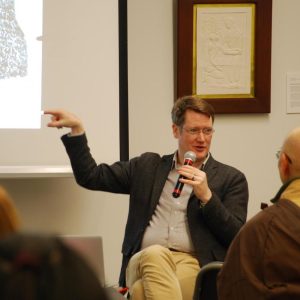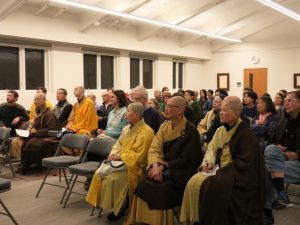
On February 28, 2019, Dr. Stefan Baums, professor of Buddhist Studies and Sanskrit, Prakrit, Pali language and Literature at University of Munich, presented an introduction to his work on ancient Buddhist manuscripts from Gandhāra. These manuscripts, written in the Middle Indian language Gāndhārī and the Kharoṣṭhī script on birch-bark scrolls, were recently discovered in the ruins of ancient Buddhist monasteries in Pakistan and Afghanistan. It was discovered that Buddhism was introduced to the Silk Road in these areas.
Dr. Baums described that some of these texts were found hidden away in clay vessels, oftentimes with significant portions missing, meaning that he and other researchers would often have to decipher the approximate order in which they originally written. In the preservation, translation, and research process, he described that these texts are stored in temperature controlled, fireproof rooms so that the ancient texts can be protected. Dr. Baums brought along photocopies of the birch-bark manuscripts so that audience members could pass them around and look at the actual size and composition of these texts. In tandem of translating the Gāndhārī texts, Dr. Baums is working with Andrew Glass on compiling and editing the Dictionary of Gāndhārī. He concluded his lecture by placing the same or similar suttas translated into English from Sanskrit, Pali, Gāndhārī, and Chinese side by side. With this comparison, it was clear that even the same suttas did not contain the same exact content in different languages, engaging the field of Buddhist hermeneutics.

